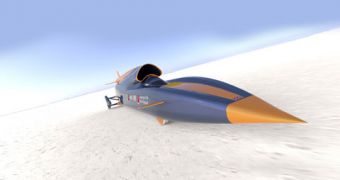The Bloodhound SSC (Supersonic car) is currently in the making at the Swansea University, and will apparently be ready by 2011. It will attempt to break the barrier of 1,000 mph (1,610 km/h), while also taking down the previous record held by a land vehicle (763 mph or 1,228 km/h, established by Thrust SSC on October 15, 1997) and the low altitude flight record for a plane (994 mph or 1,600 km/h). Mach 1.4, the speed that Wing Commander Andy Green (the same pilot that drove Thrust SSC 11 years ago) will try to achieve, literally means crossing what would be the length of four football fields in a second.
This is faster than a regular pistol bullet, but experts believe that the 12.8-meter long car, weighing more than 6.4 tons, will make it. Although it's powered like a rocket, the device is more complex than one. Its wheels, of 0.9 meters in diameter, will spin approximately 10,000 times per minute, propelling it from 0 to 1,050 miles per hour in about 40 seconds, causing the air pressure at top speed to reach 12 tons on square meter on its titanium and carbon fiber body.
“Once you start approaching, and go beyond the speed of sound, you can no longer send a pressure wave forward to tell the air ahead of you you're coming,” shares research assistant Ben Evans from the School of Engineering at the Swansea University. “What happens is a big pressure wall builds up in front of you. Rather than air slowly and smoothly getting out of the way, at supersonic speeds, these changes happen very suddenly in a Shockwave. What we're trying to understand is what happens when this shockwave interacts with a solid surface which is a matter of centimeters away.”
There's still much fine-tuning to do and a lot of aerodynamics design problems to work through, in order to compensate for all the inconveniences that such a speed may generate, especially in the sand of the desert. The number of wheels, their size and placement, or the shape of the “nose” (that has to minimize impact on the desert floor without lifting the car in the air) are just a few of the issues that scientists are trying to work out.
If the car successfully achieves its goal, it would prove essential in the creation of better designs, and in terms of fuel usage for aircrafts and land vehicles, but also a big step for medicine. Doctors are eager to learn from this test, since the pressure that Bloodhound SSC will experience is comparable with that of blood during aneurysms.

 14 DAY TRIAL //
14 DAY TRIAL //